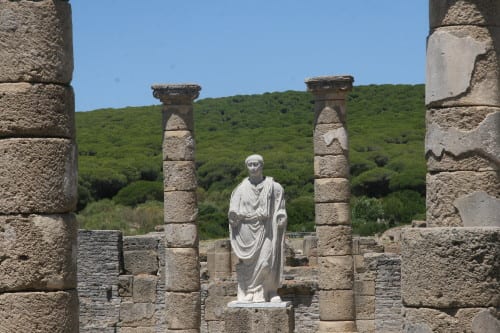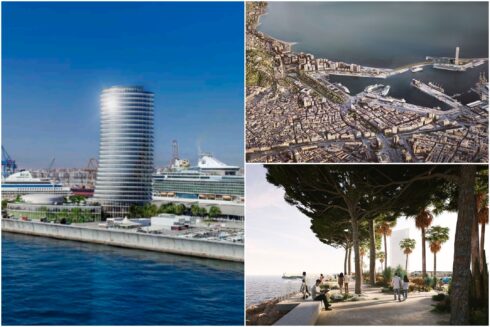By Tom Powell
THE pungent scent of tuna is wafting down the street from the salting factory, while toga-clad townsfolk make their way to the forum to shop and socialise.
It’s mid morning, and maybe later – in the heat of the day – they will duck for cover and chill out at the town’s spa, punish a few slaves and then treat the wife to a show at the theatre.
Picture the scene at Baelo Claudia 1,800 years ago, at that time one of Spain’s most important Roman settlements.
The ruined Roman city on the beachfront at Bolonia, north-west of Tarifa on the Costa de la Luz, had a booming economy back in 2AD, based on its fish-salting industry.
Today, at this reconstructed living museum, you can walk the cobbled streets, explore old Roman villas or declaim a few stanzas by Seneca from the stage of the ancient amphitheatre.
Stepping through the town gate and exploring this once magnificent Roman city is more than enough to set the imagination racing.
Nowadays the Costa de la Luz is home to hippies, kitesurfers and beach-lovers, but the serene wonder of the place hasn’t changed in eons.
It is, without a doubt, still the most stunning, varied and unspoilt coastline in southern Spain (with the Cabo de Gata its only near rival). Perfect for family holidays, romantic weekends or just a day out from the Costa del Sol, diversity abounds here.
The light makes this coast a photographer’s dream, while it is as activity-laden as it is picturesque.
‘Breathtaking’’ and ‘windy’ are certainly two adjectives often used to describe trendy Tarifa – the wind and kitesurf capital of Europe.
Glimpsing its long crescent beach of pristine white sand from atop the winding uphill road from Algeciras, flanked by battalions of flailing wind turbines, it’s not hard to see why.
Here, where the Atlantic meets the Mediterranean, kitesurfers dominate the skyline. It’s clearly these water sports lovers who create the laid-back vibe that makes Tarifa a favourite party town. Its pretty, cobbled streets teem with life and the place comes into its own after dark, when twinkling bar signs light up like stars on every corner.
One of the best things about Tarifa is the view of the Gibraltar Straits, hemmed in between Europe and Africa, with the beautiful Mediterranean to the east and the vast, wild Atlantic to the west.
Standing on the town’s narrow walkway separating the two waters reminded me of when I used to try and put one foot in the English counties of Berkshire and one in Hampshire, as a youngster. The path connects the mainland with Isla de las Palomas but unfortunately, it’s not currently open to the public, although there is talk of it happening later this year.
It is not just the wind that attracts tourists to this kitesurfing Mecca. There are whale watching and scuba diving trips and oodles of opportunities for retail therapy. Indeed, Tarifa has an abundance of quirky shops selling handicrafts, leather bags, jewellery and musical instruments, as well as pavement cafes touting freshly-baked treats.
There’s a small town beach, Playa Chica, lapped by the Med (and great if the Poniente is blowing a hooley).

But the focal point is Calle Alameda, a lively Spanish walkway lined with good restaurants, including the newly-refurbished Petit Bistro for classy French cuisine. There’s frequently live music and an extensive book market to peruse.
Across the road, the refurbished grand fort, overlooking the bustling harbour, has recently reopened to the public, providing wonderful views of the Straits.
This little fishing town was the first point of the Moorish invasion of southern Spain in AD711, when the Berber chief landed from Ceuta with 400 foot soldiers and 100 horsemen. They built the fort later, in 960AD.
It is a lovely ride from here to Bolonia, through stunning undeveloped countryside and pine fronded beaches, with kites bobbing up above on windy days. There is a vast selection of world-class hotels here, the oldest and most established being the Hurricane.
On the way to the fascinating ruins of Baelo, I was first struck by the breezy nonchalance of Bolonia, a seaside town that takes a casual, dressed-down approach to tourism. It doesn’t sneer or look down on the increasing number of visitors, but neither does it pander to their every whim like a certain neighbouring Costa…
The village road is in such bad repair you feel it wants to stay that way, a reminder to visitors that Bolonia is a natural, no-frills resort. But the march of tourism is inevitable when the beaches are as wide and white as Bolonia’s.
Its iconic, giant sand dune is the texture of icing sugar, its waters Caribbean blue. It’s hard to believe the glitzy manmade resorts of the Costa del Sol are just an hour’s drive around the headland.
Add the spectacular ruins of the Iberian Peninsula’s biggest Roman city – complete with walls, aqueducts, baths, temples, forums, villas and more – and Bolonia becomes a rather special place. It is designed to be taken slowly, at a stroll, while breathing in the fresh Atlantic air as the wind wafts you gently through the ruins.
Baelo’s main road – decumanus maximus – runs from east to west, connecting two large town gates. From here a well-signposted route leads you around the Roman settlement, with plenty of information in Spanish and English to accompany the strikingly well-preserved ruins.
The town had really started growing in 2AD, after a Baelo-made product, known as garum, took off among the chattering classes of Rome.
Made out of fish guts it was a pungent, but allegedly tasty addition to any meal and the whole area became dedicated to its production, with Roman ships arriving and departing on a daily basis for Italy, loaded up with the magic product.
After quenching my cultural thirst, I made a beeline for the alluring beach, which is fronted with a cluster of laid-back chiringuitos serving up fresh seafood and jugs of ice-cold sangria.
Sun worshippers in the know set up camp in the more sheltered zones, but Atlantic gusts are a quintessential part of what makes Europe’s ‘deep south’ so special.
And that super-sized sand dune – the largest on the continent – dares to be climbed, just to see what lies beyond. Without a moment’s hesitation I kicked off my shoes and raced up on all fours.
Admittedly, there was nothing on the other side – no secret cove or crock of gold – just a slow transition into cool, scented pine forest.
But the stunning views from here – a reminder of how all coastal Andalucia once was – made the climb nonetheless worthwhile.
It was to the southerly stretch of gorgeous beach that I ventured next, past Cala del Picacho, for some therapeutic mud-baking.

I had heard that mud treatments are popular here and, despite being blessed with naturally smooth skin (he boasted), it seemed the perfect way to top off a spot of Roman exploration and dune-climbing.
I got to work, smashing up some wet slate stone to create my own mudpack, adding a pinch of seaweed to give a creative twist to my recipe.
I slapped it on, scraping the ground-up rock into my skin, wincing ever-so-slightly while trying to retain an air of cool in front of the families walking past.
My patchwork mud coat dried out in no time and I was soon in the Atlantic rinsing off, exfoliated and born again – or something like that.










Last year in October I took the family for 3 days up the coast to Bolonia and we had an amazing time. The beach there is not only huge but surrounded by some lovely forests and wonderful scenery which is has been ruined like a lot of the plastic costa del sol. The highlight of the beach was the huge dune and we were amazed to see cows wandering around. It is very basic out of season with what much open but we had a great quiet time away from madness of where we live in Fuengirola.
The roman ruins we visited on our last day and are amazing
Off the far end of Bolonia beach is excellent for snorkelling.
Beware of the speed camera as you exit turning right towards Tarifa onto the main Cadiz-Tarifa road.